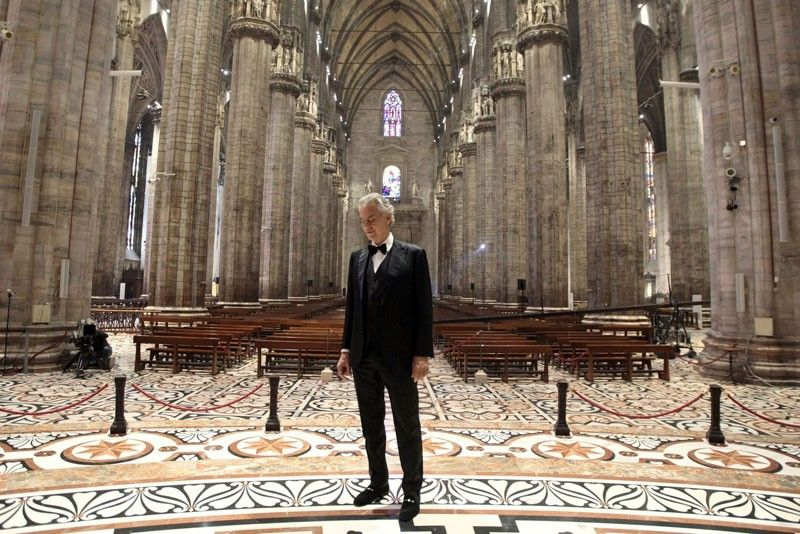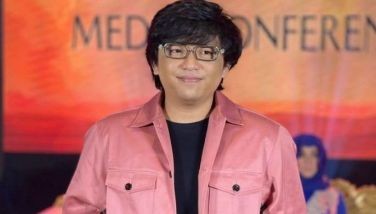Bocelli’s music for hope & healing

Music, the most universal and the most profound of the arts, has been playing a most active role in the ongoing worldwide battle against COVID-19.
Amidst a time when lives are imperiled and economies are on the decline, there is music. A tune can lift up spirits, ease the tension with a cherished memory or simply provide a much-needed distraction.
One of music’s most glorious moments in recent times happened last Easter Sunday, April 12. That was when Andrea Bocelli performed at the historic Duomo di Milano, the ornate cathedral dedicated to the Nativity of the Blessed Virgin Mary in Milan, Italy. With the whole country in lockdown, the 61-year-old tenor sang to an empty church. Titled Music for Hope, the show has now been seen over 36 million times on YouTube and is now the biggest ever classical live stream in history.
The Italian Bocelli is the world’s most successful crossover artist. That means that he is both a big seller as a pop star and a classical tenor. He sings both Puccini and David Foster. He has sold over 80 million records. Among his biggest hits are Con Te Partiro (Time to Say Goodbye), Miserere and The Prayer, a duet with Celine Dion. It has been said that he has the most beautiful voice in the world. A few weeks ago, he was invited by the City of Milan and the Archpriest of the Duomo to do a concert in the cathedral. The result was an event that will be remembered for a long, long time.
The Piazza del Duomo is the center of Milan. Located around it are a large train station, that is one of the busiest in Europe; the famous Teatro de la Scala, where all the great opera singers have performed; the Royal Palace, which is not in much use since Italy ditched the monarchy many years ago; and favorite stop of everybody, the glass-domed Galleria Vittorio Emmanuelle II, which is the oldest and the biggest mall in the world.
The mall of Duomo has everything, from Old Navy to Prada and every kind of cuisine you can think of including Jollibee. Legend also surrounds it. If you step on the testicles of the Turin bull on the mosaic floor and spin on your heel three times, you will have good luck. Needless to say, a hole has already formed on the bull’s testicles.
Then, there is the church. It is a gothic edifice with 135 spires, huge and a true sight to behold. One great thing about being quarantined and living before screens of assorted sizes most of the day is that you get the chance to see things in close-up. Virtual, yes, but a feast for the eyes. And last Easter Sunday, bereft of the hordes of the usual tourists, Milan’s Duomo rose to the skies in exquisite beauty.
On the steps leading to the altar was Bocelli, handsome and distinguished in his black tuxedo. His was a short, simple repertoire of sacred music. Accompanied only by the church organist Emanuele Vianelli on the large pipe organ, he sang Franck’s Panis Angelicus, the Bach-Gounod Ave Maria, the Sancta Maria by Mascagni and the Domine Deus by Rossini. Shown on the screen from time to time were images of the majestic Duomo and empty cities, Paris, New York, London and Milan. It was heart-rending to watch.
To close, Bocelli went out to the entrance of the cathedral. There alone he sang the hymn Amazing Grace to the empty plaza. Empty, yes, but in the end, his message of love, healing and hope went out to Italy and to the whole word. It was not a concert. It was an expression of faith in God. Music for Hope was a prayer that united the world and surely delighted the angels.
Music for Hope was a project of the City of Milan and the Veneranda Fabbrica del Duomo. It was produced by Sugar Music and the Universal Music Group in collaboration with YouTube. It was the contribution of the video streaming giant that made the concert possible. Bocelli performed pro bono. Proceeds went to the Andrea Bocelli Fund and will benefit frontliners and hospitals.
- Latest
- Trending




























